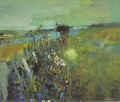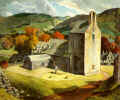During the summer of 1996 the City Art Centre brought three fascinating exhibitions to Edinburgh. For an entry fee of just £3, £2 for children and concessions, visitors had the opportunity to wonder at artistic craft from civilisations separated by vast expanses of distance and time.
GATEWAY TO THE SILK ROAD
Relics from the Han to the Tang
Dynasties, from Xi'an, China
The City Art Centre was delighted to announce a second major exhibition from the ancient city of Xi'an. The first, `The Emperor's Warriors' staged in 1985, was drawn from the vast terracotta army interred with the first emperor of China and attracted 250,000 visitors. Xi'an, once the ancient Chinese capital known as `Changan'is one of the birthplaces of human civilisation. The Chinese authorities have identified 4,000 sites of archaeological interest within the city, some 300 of which are regarded as being of international significance.
Xi'an was the first city of ancient China to open to the outside world. The reason? Silk, one of China's great gifts to the world, and for many years a major trading commodity. Silk was first produced in China around 1276 BC, and it retained an exclusive monopoly in this much sought after fabric until silk worms were smuggled West at some point during the 6th century AD. Although their monopoly was broken, the Chinese were to retain their position as the world's major silk exporter from a further 1,000 years.
It was the market for silk in the ancient Mediterranean world that led to the development of the `Silk Road', the name given to the overland routes which ran through Modern-day China, Tibet, Nepal, Afghanistan, Pakistan, Iran, Iraq, Georgia and Turkey, the westwards via the Mediterranean.
As Chinese power waxed and waned over the centuries, trade over the Silk Road also rose and fell. The heyday of the Silk Road was from about 1200-1360, when safe passage was guaranteed by the awesome power of the Mongols, under their great chieftains Genghis Khan and his grandson Khubilai Khan. It was during this period of Mongol control that the Venetian trader Marco Polo travelled the Silk Road, becoming a favourite of Khubilai Khan. Polo's accounts have been contested through the centuries, however, modern scholarship has confirmed the accuracy of Polo's account of life on the Silk Road.
`Gateway to the Silk Road' was the story of Xi'an's role as the eastern terminus of the ancient trade route. It brought to Edinburgh some 100 objects reflecting the history of the Silk Road, and the merchants that travelled it. The earliest pieces in the exhibition, bronze vessels date back beyond 1,000 BC but the majority of the pieces, wrought in gold, jade, glass and ceramic, date from the later Han and T'ang dynasties. A varied range of ceramic figures are wonderfully observed and capture the range and skill of the Han potters. The central importance of silk is captured in one of the most delightful antiquities in the exhibition - a small silk worm in bronze.
The objects also reflect foreign influences which found their way along the Silk Road. These include several images of the Buddha, a gold Byzantine coin and a ceramic figure of negro.
CHRISTINA ROBERTSON
A Scottish Portraitist At the Russian Court
Edinburgh-born Christina Robertson lived an unconventional life for a nineteenth century lady. Not only did she succeed as an artist, no little accomplishment for a woman in the early nineteenth century, but she also took the daring step of quitting Britain for St.Petersburg, and a career painting portraits of the Russian Imperial family.
Born around 1796. Christina probably trained in Edinburgh under the direction of her uncle, George sanders, before moving to London and marrying the artists James Robertson. She developed a successful career painting miniatures and portraits of British and European nobility, and then in 1840 made the move to St. Petersburg.
Christina Robertson's work became very fashionable at the Russian Court and her sitters included members of Czar Nicholas I's immediate family, including the Empress Alexandra Fedorovna.
The majority of Robertson's Russian work is held by the Hermitage Museum, St. Petersburg. The works from the Hermitage form the core of what will be the first comprehensive exhibition of Christina Robertson's work, staged fittingly in the city of her birth. The paintings from the Hermitage will be supplemented by pictures from the Russian State Museum, St. Petersburg and by rare paintings unearthed in private collections in the UK.
HEARTLAND
Scottish Landscape Art in the 2Oth Century
The last major exhibition devoted to Scottish landscapes, staged by the National Galleries in the 1970s, covered the period up to 1900. `Heartland' began where that earlier exhibition signed off, by concentrating on the important Scottish landscape paintings of the 20th century.
 |
 |
 |
 |
The starting point of the exhibition was the work of William Taggart and the more radical work of the `Glasgow Boys' in paving the way for the Scottish Colourists. The fluid handling of paint, and rich vibrant colours, which were the hallmarks of the Colourists, lent themselves to a re-interpretation of Landscape, a theme they all tackled. Peploe and Cadell were inspired by the sanctuary of Iona, while Leslie Hunter depicted the area around Loch Lomond in bright and strident hues. J.D. Fergusson, the fourth member of the group, lived most of his adult life in France, and his view of the French countryside reflect the influence of French painters such as Cezanne. The exhibition also featured several works by Sir William Gillies who forms a bridge between the influences of the Colourists and the those artists referred to as `The Edinburgh School'. The exhibition concluded by looking at the work of modern artists working within the broad parameters of landscape.
 |
 |
 |
 |
The City of Edinburgh's own fine art collection forms the core of Heartland, but was supplemented by loans from private, public, corporate and national collections.